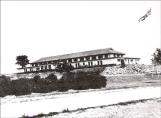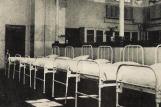2
The Triple Barracks was the scene of one of the more famous escape attempts by the POWs. It was an attempt to get Otto Kretschmer back to Germany. Kretschmer was the famed U-boat Captain of u-boat 99. He held the record for the most Allied ships sunk during WWII- 50 ships sunk by Kretschmer. What is most amazing is that he was captured in 1941 and spent the majority of the war years interred in Bowmanville. For the rest of the was, no other U-boat captain was able to match or break the record that he set in the first eighteen months. Churchill stated that the U-boats were Hitler's most leathal weapon and Kretchmer was Hitler's most talented U-boat commander. Kretschmer's talents as a U-boat commander had even resulted in an invitation from Hitler to dine with him. Hitler wanted Krestchmer back in the war and there were many plots to try and gain his freedom from Bowmanville, including Hitler sending a submarine to the east coast of Canada to wait for Kretschmer and return him to Germany.6
Otto Kretschmer oversaw one of the major tunnel projects at Camp 30. It was directed from the Triple Barrracks or House IV and it was the longest tunnel dug from Camp 30. They went out the east side of the building, under the roadway to emerge in the bushes in the farmers field. The biggest issue with digging the tunnel was where to put the dirt. They decided to hide it in the ceiling of House IV. On the evening before the escape, a portion of the ceiling collapsed under the weight of the dirt and the tunnel was discovered by the Canadian guards. It was very frustrating for Kretschmer as the rest of the escape had already been arranged . Prisoners had collected Canadian currency shipped in the false bottoms of cans and flaps of packages. They had charts and maps of Canada's terrain including the east coast which was Kretschmer's destination. A German submarine had also been dispatched and was waiting to pick up Kretschmer at Maisonette Point in the Bay of Chaleur. Another prisoner decided to take advantage of this submarine when Kretschmer was caught and unable to make his date. Knowing the submarine was waiting off the coast, Lieutenant Commander Heyda used a pulley like a clothes line pulley on electrical lines to carry him over the fence and to freedom. He made it to Maisonette Point without incident but found the normally desolate place crawling with Canadian soldiers. The British had learned of the escape plan by breaking the code used by German submariners. Heyda attempted to contact the submarine but was captured by the Canadians and eventually returned to Camp 30.7
The hospital that became known as the General House during the time of Camp 30Circa 2005
Bowmanville, Ontario, Canada

8
The building shown in the previous picture was constructed in 1937 as a hospital for the boys. It was constructed a decade after the original buildings on the site and does not follow the lines of Prairie Style architecture. It housed the nurse, doctor, and dentist offices and its upper floors were ward rooms for sick boys. There was an outside verandah on the north side of the building (on the left side of previous picture) where the boys were taken for fresh air.In the 1970's near the end of its tenure as a training school, girls were admitted and this building served as their dormitory. During the time of Camp 30 however, this was the Generals House. We are aware of three Generals who were held at Camp 30 by the names of Schmidt, Friemel and Von Ravenstein. Von Ravenstein served in the African Desert under Rommel. In addition to Von Ravenstein, there were 300 POWs from Rommel's command. Von Ravenstein served as the head of the camp for the POWs. This building held his rooms including his barracks and office where he would hear and resolve the day to day issues of POWs in the camp.
The POWs had their own disciplinarian system including committees that were responsible for operations throughout the camp. Once such committee was the Escape Committee. If a POW had a plan for an escape, he would present it to the committee for approval. There was a very famous escape from the camp that did not receive approval from the committee although they told the POWs they would not try to stop them if they decided to go ahead with their plan. In this escape, two POWs by the names Oberleutnant Peter Krug, and Leutnant Erich Boehle, hatched a brilliant idea for escaping. They had conceived the idea of posing as Canadian workmen going about their daily routine of repairing various things in need of maintenance.
10
On April 17th 1942, the two men, with the help of the entire camp, started to walk toward the double barbed wire fences. The men were of course being guarded by one of their own men wearing a Canadian army uniform, which was provided by the POW's own theatrical group.Pretending to be repairing the barbed wire fence, and marking the spots with paint, the two men climbed the first fence using a ladder and went over the top. After successfully climbing over the second outer fence they sat down for a rest and a few minutes later, stood up and proceeded to just walk away.
The men made it successfully to Union Station in Toronto where they decided it would be best if they were to split up. Leutnant Erich Boehle was captured on Lewiston Road only a mile from potential freedom in the United States. Peter Krug however had a much more exciting and longer flight of freedom. The Camp 30
commandant, Colonel Bull, received a phone call from the Niagara Falls Police Department asking him if he were missing any prisoners. Colonel Bull ensured the constable that indeed he was not. The constable insisted and asked him to check again specifically for one Erich Boehle. Yes, they did have a POW named Erich Boehle but at roll call he was not missing, how could this be? Another elaborate and brilliant idea of the theatrical group made it possible and likely would not have been detected for some time if it had not been for Boehle being picked up so quickly.
The theatrical group had made dummies using papier-mâché, a uniform, and plenty of paper stuffing. The dummies had been hauled out for each roll call and strategically placed in the middle of the bunch while being held upright by POWs on either side. After a double count of POWs, still no one was missing. Colonel Bull ordered aN oral count where all POWs would have to call out when their names were called and it was only then that it was found that not only was Leutnant Boehle missing but Oberleutnant Krug was as well.
Oberleutnant Krug made it all the way to San Antonio Texas where keen eyed hotel manager recognized Krug from an FBI photo. The manager contacted the FBI who quickly arrested the surprised Oberleutnant Krug. Peter Krug was eventually returned to Camp 30 where the commandant immediately began processing paperwork to have him transferred to the more secure POW camp at Gravenhurst.





